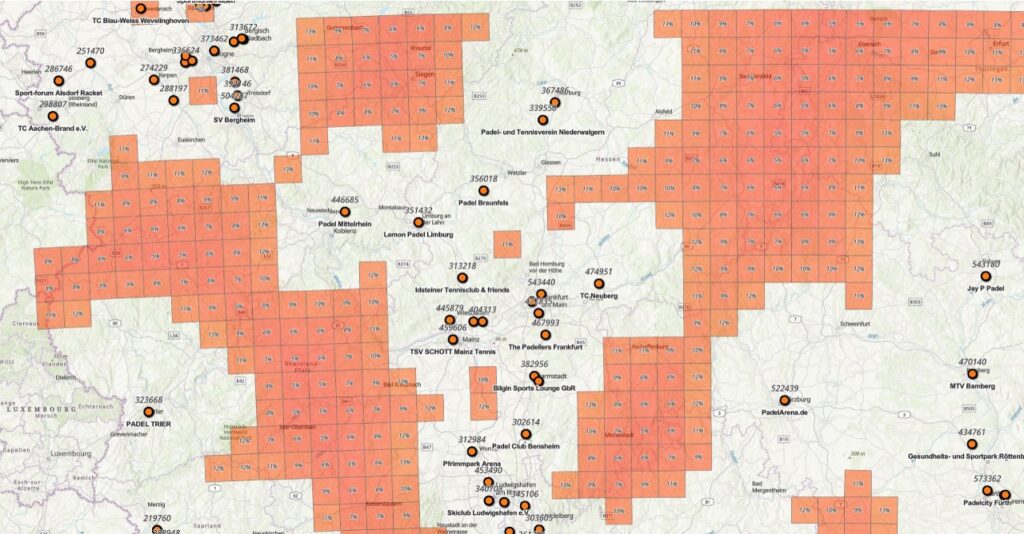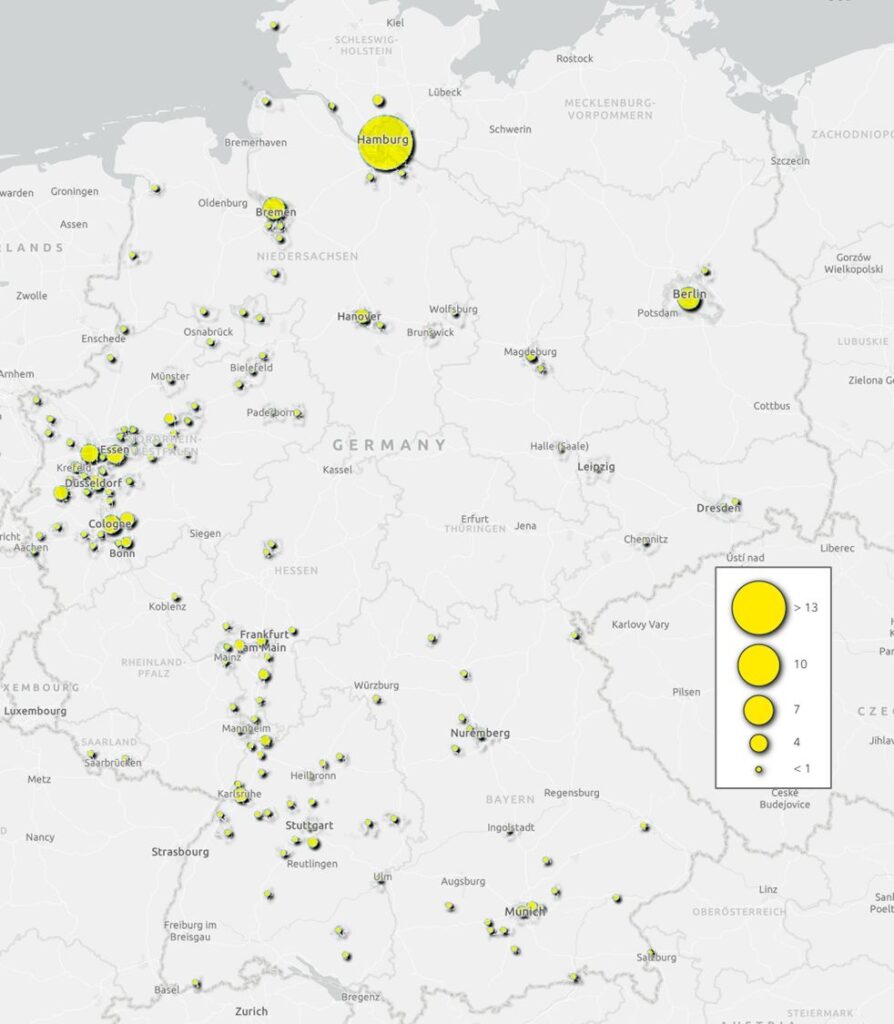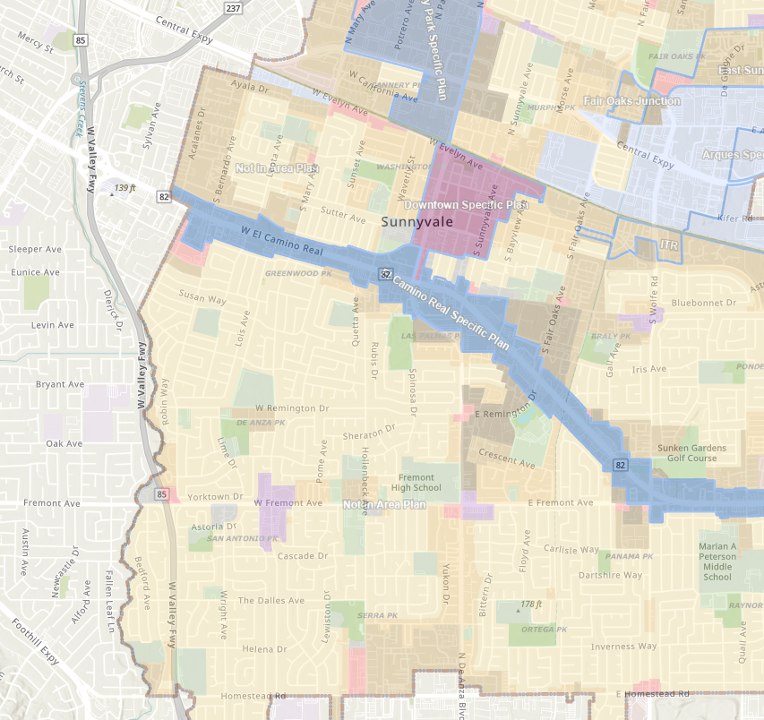Why the Future of Successful Padel Clubs is Data-Driven
In the increasingly competitive global market for Padel clubs, success is no longer just about having a great court or location – it’s about having the right location, validated through data. The rise of location intelligence – geospatial data that supports real-time, strategic decision-making – has transformed industries like retail, logistics, and finance. Now, it’s time for the Padel sector to capitalize on these same tools to ensure long-term, sustainable profitability.
From Gut Feeling to Data-Driven Decisions
Too many padel clubs are launched based on instinct or opportunistic property deals. But as competition rises and early-mover advantages fade, data must replace guesswork. Location intelligence enables investors to make smart, evidence-based choices about where to build, who to target, and how to scale operations.

What Leading Sectors Already Know
Other industries have proven that using geospatial data leads to real, measurable benefits:
- Retail & E-commerce: 11–15% higher average basket sizes and 3–4% lower delivery costs through targeted geo-based promotions and optimized logistics.
- Logistics: 5–11% savings on delivery costs and 6–11% higher customer satisfaction by optimizing route planning with real-time mapping.
- Finance: Up to 30% reduction in fraud through address verification and localized services.
- Food Delivery: Up to 25% EBITDA growth by dynamically adjusting pricing to local purchasing power and tracking delivery progress in-app.
Padel is next based on our experience in multiple markets where investors are not paying much attention to their long-term strategy and having lack of understanding how important role property strategy is playing in building sustainable competitive edge.
Padel Is Still Fragmented. Location Data Creates Long-Term Winners.
The padel boom has attracted many first-time investors and fitness entrepreneurs. As a result, many clubs are built without validated catchment data, leading to high churn, underused courts, or failure to attract recurring players. Can we learn something from the history of other racket sports like squash which had its boom and bust later, and now trying to recover from its bottoms.

It is crucially valuable to learn from other people’s mistakes or other entrepreneurs errors in decision making and lacking a clear strategy for a growth path in building Padel club chain. At PADEL1969 we can see that all the same “rookie mistakes” are done in new emerging markets that have been done with padel enthusiastic investors and entrepreneurs in Sweden, Finland and Italy. Learn more how invest smart in Padel by reading Boom or Bust article.
But location intelligence can change that. With the right tools and insights, investors can:
- Identify high-potential micro-markets within urban, suburban, and resort areas.
- Map the proximity and strength of local competitors.
- Analyze player density, income levels, transport access, and existing sports facility saturation.
- Forecast club utilization rates and pricing sensitivity by location.
- Plan marketing and customer acquisition, activities before and after opening the padel club.
This is not theory. This is how scalable padel clubs are being built across Europe, United States and the Middle East right now – with location data embedded into every stage of planning.
How Location Intelligence Directly Drives Padel Club ROI
- Build Where the Players Are (and Will Be)
Predictive geospatial analysis identifies underserved high-potential catchment areas. This allows you to secure premium sites before demand peaks, ensuring strong footfall, higher court utilization, and better lease terms. - Avoid the Race to the Bottom
Many clubs in oversaturated or misjudged markets end up competing on price. With data, you build where pricing power is protected by real demand, minimal direct competition, and customer willingness to pay for quality. - Segment and Target Your Audience
Map real local demographics and behavior patterns – such as active lifestyle clusters, family density, and corporate presence – to align your offering (coaching, events, memberships) with audience fit and revenue potential. - Optimize Staffing, Events, and Operations
Location insights reveal peak hours, off-peak potential, and traffic patterns. This empowers better decisions around coach availability, club opening hours, dynamic pricing, and event planning. - Lower Customer Acquisition Cost Through Precision Marketing
Whether running paid digital ads, distributing flyers, or hosting activations, location intelligence allows you to hyper-target by postal code, behavior, or income group. You avoid wasting budget on low-converting areas and instead focus spend on zones with the highest conversion potential, dramatically improving customer acquisition cost (CAC) and campaign ROI. - Maximise Market Potential and Set KPIs for Penetration
Data tells you not only where players are—but also how many you can realistically reach and convert. This helps you set clear KPI benchmarks for member acquisition, court usage, and community penetration. With this, you can monitor performance, adjust strategies in real time, and confidently judge when a market is fully saturated—or when there’s still room to grow.
Leading Investors Are Building Location Intelligence into Their Core Strategy
What separates padel club investors who scale from those who stall?

According to research across multiple industries, top-performing companies use location intelligence not only for operational wins – but as a strategic asset.
They:
- Model ROI from the outset, using data to validate each new site.
- Run A/B tests on promotions and layouts to see what drives engagement.
- Use multi-touch attribution to connect location-based campaigns with revenue.
- Partner with location data providers to keep insights fresh, accurate, and scalable.
These same principles apply directly to padel. Whether launching your first club or expanding internationally, your success increasingly depends on how you use data – not just where you build.
This Is the Moment to Act Smarter Than the Market
In the next phase of padel growth, many clubs launched on enthusiasm alone will struggle. Only those with a long-term, data-led strategy will thrive. This means going beyond the basics – beyond just picking a city or a trendy zone – and embracing location intelligence to gain and protect your competitive edge.
Build where it makes sense. Back your decisions with data. And create clubs that outperform – now and in the future.
Want to build the benchmark padel club in your market?
We at PADEL1969 combine the best padel club products with advisory services, performance analytics, and in geospatial data to help our clients build winning clubs and make their impact to the growth of padel in sustainable way.
Contact us at [email protected] to explore how.
Author: Atte Suominen, Founder & CEO at PADEL1969
PADEL1969 | from Acapulco since 1969.


